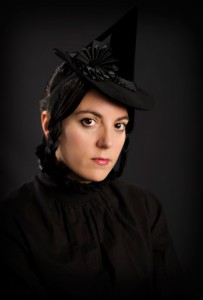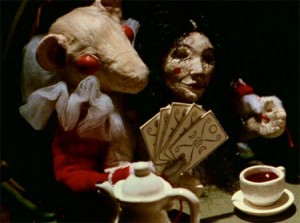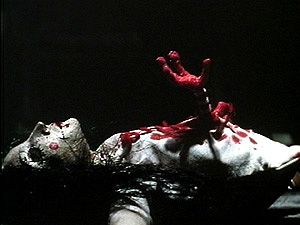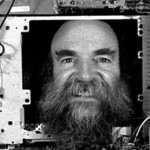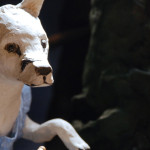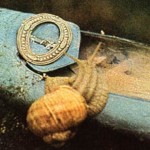DOWN THE RABBIT HOLE
DOWN THE RABBIT HOLE: AN INTERVIEW WITH INDEPENDENT STOP-MOTION ANIMATOR CHRISTIANE CEGAVSKE, OF BLOOD TEA AND RED STRING
Kier-La Janisse
It’s been 5 years since Fantasia premiered a bizarrely beautiful stop-motion feature called Blood Tea and Red String – something I’ve flippantly summarized elsewhere as ‘Beatrix Potter in Hell’ – an incredibly dense experimental animation project 13 years in the making. With its down-the-rabbit-hole sensibility of a little girl lost in that magical place between childhood and womanhood, full of strange, elaborately costumed animals, bodily mutilation and no dialogue to neatly convey its narrative trajectory, Blood Tea and Red String fascinates both visually and subconsciously. Since first seeing the film all those years ago, its creator Christiane Cegavske has often crossed my mind, and I routinely check in to see where her follow-up feature A Seed in the Sand is at in production, knowing that due to the labour-intensive nature of independent animation, it will be some years before completion. In the meantime, Christiane has busied My wife glad to see me in action again :) I'm gonna buy new bed this week, haha free sample pack of cialis. Online Canadian Pharmacy provides one of quickest and easiest ordering processes available oline today. herself with a number of other projects including a hand-made boardgame, Victorian era-inspired costumes, paintings, drawings and various other crafts that are available through her etsy site HERE. Spectacular Optical was thrilled that Christiane took some time out to answer a few questions about her working process and her thematic obsessions.
————————-
Can you tell me a bit about the story for A Seed in the Sand, and what the writing process is like? Do you start with a story or with a visual inspiration that you create a story around?
The theme for Seed in the Sand revolves around following inspiration, abduction, abandonment, seeking and nurturing. In a burned dead land inhabited by furry white creatures with red beaks and pointy ears, a woman arrives and plants a gem in the ground as if it were a seed. The seed/gem grows into a plant with a pod. With the pod also grows cialis fast hope and greed.
My stories usually start by a flash of inspiration which erupts into my consciousness and combines with images and ideas that I had been working on that had seemed to be unconnected before. From that point I write notes and make sketches as bits of story come to me. Once I feel that there is enough material I will organize it and type it up on the computer as a script.
What equipment do you use to make your work? What are the differences, if any, between the process of how you’re making the new film and how you’ve worked previously?
The puppets are similar to, but much sturdier than, the puppets from Blood Tea and Red String. This time though they have strong magnets in the feet and the sets will have metal sheets under a thin coating of dirt or other material depending on the scene. Also, Blood Tea and Red String was shot on 16 mm film but Seed in the Sand will be shot in HD using a Canon 7D Camera and Dragon Stop Motion on a Mac.
How long have you been working on the new film Seed in the Sand? I noticed your Kickstarter was successful! But how much of the filming costs does this funding really cover? It was a pretty modest request for a project as ambitious as yours.
The earliest sketches and notes for Seed in the Sand start late 2003 to early 2004, though the characters show up a couple of years earlier in sketches. I wrote most of the script in 2007 and revised it quite a bit very recently. I started making the characters in 2008, but progressed very slowly.
The Kickstarter budget only covered the new computer, camera, computer programs and a few materials for the first set and recording costs for the first song by Mark Growden. I can finish all of the filming on the first set with what I have now. I will need to find more support for my project as I go along and hopefully this first portion will inspire that support to come my way.
What is the most time consuming part of your filmmaking?
The animation is the most time consuming part of the work. It is very labor intensive. Getting ten seconds done counts as a really successful day!
Do other work projects compete with your attention on big projects like this – making music videos, day jobs etc? How much of the 13 years it took to make Blood Tea and Red String was spent working continuously?
Oh yes, most definitely. I think if I condensed the time actually spent working on Blood Tea and Red String, it would come out to about five years. Oh, how I wish I had the kind of support that would make that kind of time line possible for Seed in the Sand.
How did you first become interested in stop motion?
I am sure it was the Rankin/Bass Christmas specials that got me started down that road and I have made little dolls and puppets since I was just tiny. Then, in fifth grade, I made a little stop motion film in super 8 film about some kids who went trick-or-treating and another with some eggs dancing on a kitchen counter. Seeing Alice, by Jan Svankmajer, while I was in art school really brought it all up to the surface again for me and stop motion became my main focus.
I love your bestiary and the mix of girlishness and very dark themes. Do you think girlishness inherently has this kind of darkness to it?
Thank you. I remember a friend once told me that pink goth was really the most goth one could be. Perhaps she was right. I haven’t quite made it that far yet. I am not sure if girlishness inherently has the darkness in it or if it just attracts a predatory darkness and the two become intertwined.
So much is textile-based – in addition to your films you also make costumes – where does this interest in fabrics and very labour-intensive crafts come from?
As I mentioned earlier, I have made dolls and puppets since I was tiny. The very first doll I remember making was a little Virgin Mary out of my mother’s sewing scraps when I was five. That was soon followed by Big Bird and Oscar the Grouch. Since my mother and grandmothers sewed, it seemed like a natural thing to do. I just took it in a different direction from them.
Even your boardgame is a hands-on, tactile game at a time when so many games are made specifically for computers. Tell me about your boardgame – do you have a larger interest in boardgames/boardgame design in general?
I was invited to participate in a toy art show. So, I came up with the game, Doll Hunt, for that. It was a fun challenge and I instilled it with images and themes from my other work. I do enjoy board games, but I wouldn’t claim them to be a strong lure for me. Chances are, Doll Hunt will be my only one.
Where did your interest in the Victorian aesthetic stem from? Why does it fascinate? Do you feel like the animals and birds are somehow linked to some kind of Victorian ethos?
I’m not sure how I first became drawn to the Victorian aesthetic. My earliest exposure would most likely have been from movies and old story books. Beatrix Potter is an early influence and lifetime favorite. I’ve always had an especial fondness for a frog in a tail-coat, so perhaps I just wanted to dress properly to be his date.
Who are some artists who have inspired you?
Leonora Carington, Leonor Fini, Jan Svankmajer, Hieronymus Bosch, Sandro Botticelli, Frida Kahlo, Christine Shields, Edward Munch, Aubrey Beardsley, Dante Gabriel Rossetti…..
Would you describe these films as fables or fairy tales? Do you feel there is a morality to the work?
I suppose they are somewhere between fable and fever dream. If there is some morality to the work, it would be found in the relationships between the characters. I have not set out to design a moral for the tales, but it doesn’t seem hard to find one or two if you look. All actions have consequences.
—————–
See Christiane Cegavske’s official website HERE.

 November 1, 2011
November 1, 2011  No Comments
No Comments

